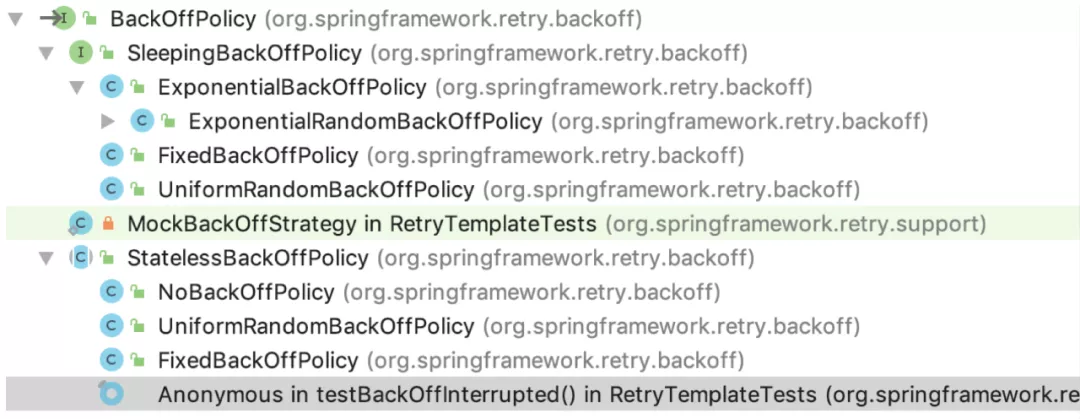概要
Spring实现了一套重试机制,功能简单实用。Spring Retry是从Spring Batch独立出来的一个功能,已经广泛应用于Spring Batch,Spring Integration,Spring for Apache Hadoop等Spring项目。这里讲述如何使用Spring Retry及其实现原理。
背景
重试其实其实很多时候都需要的,为了保证容错性,可用性,一致性等。一般用来应对外部系统的一些不可预料的返回、异常等,特别是网络延迟,中断等情况。还有在现在流行的微服务治理框架中,通常都有自己的重试与超时配置,比如dubbo可以设置retries=1,timeout=500调用失败只重试1次,超过500ms调用仍未返回则调用失败。如果要做重试,要为特定的某个操作做重试功能,则要硬编码,大概逻辑基本都是写个循环,根据返回或异常,计数失败次数,然后设定退出条件。这样做,且不说每个操作都要写这种类似的代码,而且重试逻辑和业务逻辑混在一起,给维护和扩展带来了麻烦。从面向对象的角度来看,应该把重试的代码独立出来。
使用介绍
基本使用
先举个例子:
@Configuration@EnableRetrypublic class Application {@Beanpublic RetryService retryService(){return new RetryService();}public static void main(String[] args) throws Exception{ApplicationContext applicationContext = new AnnotationConfigApplicationContext("springretry");RetryService service1 = applicationContext.getBean("service", RetryService.class);service1.service();}}@Service("service")public class RetryService {@Retryable(value = IllegalAccessException.class, maxAttempts = 5,backoff= @Backoff(value = 1500, maxDelay = 100000, multiplier = 1.2))public void service() throws IllegalAccessException {System.out.println("service method...");throw new IllegalAccessException("manual exception");}@Recoverpublic void recover(IllegalAccessException e){System.out.println("service retry after Recover => " + e.getMessage());}}
@EnableRetry - 表示开启重试机制 @Retryable - 表示这个方法需要重试,它有很丰富的参数,可以满足对重试的需求 @Backoff - 表示重试中的退避策略 @Recover - 兜底方法,即多次重试后还是失败就会执行这个方法Spring-Retry 的功能丰富在于其重试策略和退避策略,还有兜底,监听器等操作。
重试策略
看一下Spring Retry自带的一些重试策略,主要是用来判断当方法调用异常时是否需要重试。
SimpleRetryPolicy默认最多重试3次TimeoutRetryPolicy默认在1秒内失败都会重试ExpressionRetryPolicy符合表达式就会重试CircuitBreakerRetryPolicy增加了熔断的机制,如果不在熔断状态,则允许重试CompositeRetryPolicy可以组合多个重试策略NeverRetryPolicy从不重试(也是一种重试策略)-
退避策略
看一下退避策略,退避是指怎么去做下一次的重试,在这里其实就是等待多长时间。

FixedBackOffPolicy默认固定延迟1秒后执行下一次重试ExponentialBackOffPolicy指数递增延迟执行重试,默认初始0.1秒,系数是2,那么下次延迟0.2秒,再下次就是延迟0.4秒,如此类推,最大30秒。ExponentialRandomBackOffPolicy在上面那个策略上增加随机性UniformRandomBackOffPolicy这个跟上面的区别就是,上面的延迟会不停递增,这个只会在固定的区间随机StatelessBackOffPolicy这个说明是无状态的,所谓无状态就是对上次的退避无感知,从它下面的子类也能看出来原理
原理部分,一是重试机制的切入点,即它是如何使得代码实现重试功能的;二是重试机制的详细,包括重试的逻辑以及重试策略和退避策略的实现。
切入点
@EnableRetry```java @Target(ElementType.TYPE)
@Retention(RetentionPolicy.RUNTIME)
@EnableAspectJAutoProxy(proxyTargetClass = false)
@Import(RetryConfiguration.class)
@Documented
public @interface EnableRetry {/**
- Indicate whether subclass-based (CGLIB) proxies are to be created as opposed
- to standard Java interface-based proxies. The default is {@code false}.
- @return whether to proxy or not to proxy the class
*/
boolean proxyTargetClass() default false;
}
可以看到`@EnableAspectJAutoProxy(proxyTargetClass = false)`这个并不陌生,就是打开Spring AOP功能。重点看看`@Import(RetryConfiguration.class)`,`@Import`相当于注册这个Bean,看看这个`RetryConfiguration`它是一个`AbstractPointcutAdvisor`,它有一个pointcut和一个advice。在IOC过程中会根据`PointcutAdvisor`类来对Bean进行`Pointcut`的过滤,然后生成对应的AOP代理类,用advice来加强处理。看看`RetryConfiguration`的初始化:```java@PostConstructpublic void init() {Set<Class<? extends Annotation>> retryableAnnotationTypes = new LinkedHashSet<Class<? extends Annotation>>(1);retryableAnnotationTypes.add(Retryable.class);//创建pointcutthis.pointcut = buildPointcut(retryableAnnotationTypes);//创建advicethis.advice = buildAdvice();if (this.advice instanceof BeanFactoryAware) {((BeanFactoryAware) this.advice).setBeanFactory(beanFactory);}}protected Pointcut buildPointcut(Set<Class<? extends Annotation>> retryAnnotationTypes) {ComposablePointcut result = null;for (Class<? extends Annotation> retryAnnotationType : retryAnnotationTypes) {Pointcut filter = new AnnotationClassOrMethodPointcut(retryAnnotationType);if (result == null) {result = new ComposablePointcut(filter);}else {result.union(filter);}}return result;}
上面代码用到了AnnotationClassOrMethodPointcut,其实它最终还是用到了AnnotationMethodMatcher来根据注解进行切入点的过滤。这里就是@Retryable注解了。
//创建advice对象,即拦截器protected Advice buildAdvice() {//下面关注这个对象AnnotationAwareRetryOperationsInterceptor interceptor = new AnnotationAwareRetryOperationsInterceptor();if (retryContextCache != null) {interceptor.setRetryContextCache(retryContextCache);}if (retryListeners != null) {interceptor.setListeners(retryListeners);}if (methodArgumentsKeyGenerator != null) {interceptor.setKeyGenerator(methodArgumentsKeyGenerator);}if (newMethodArgumentsIdentifier != null) {interceptor.setNewItemIdentifier(newMethodArgumentsIdentifier);}if (sleeper != null) {interceptor.setSleeper(sleeper);}return interceptor;}
AnnotationAwareRetryOperationsInterceptor
 可以看出
可以看出AnnotationAwareRetryOperationsInterceptor是一个MethodInterceptor,在创建AOP代理过程中如果目标方法符合pointcut的规则,它就会加到interceptor列表中,然后做增强,看看invoke方法做了什么增强。
@Overridepublic Object invoke(MethodInvocation invocation) throws Throwable {MethodInterceptor delegate = getDelegate(invocation.getThis(), invocation.getMethod());if (delegate != null) {return delegate.invoke(invocation);}else {return invocation.proceed();}}
这里用到了委托,主要是需要根据配置委托给具体“有状态”的interceptor还是“无状态”的interceptor。
private MethodInterceptor getDelegate(Object target, Method method) {if (!this.delegates.containsKey(target) || !this.delegates.get(target).containsKey(method)) {synchronized (this.delegates) {if (!this.delegates.containsKey(target)) {this.delegates.put(target, new HashMap<Method, MethodInterceptor>());}Map<Method, MethodInterceptor> delegatesForTarget = this.delegates.get(target);if (!delegatesForTarget.containsKey(method)) {Retryable retryable = AnnotationUtils.findAnnotation(method, Retryable.class);if (retryable == null) {retryable = AnnotationUtils.findAnnotation(method.getDeclaringClass(), Retryable.class);}if (retryable == null) {retryable = findAnnotationOnTarget(target, method);}if (retryable == null) {return delegatesForTarget.put(method, null);}MethodInterceptor delegate;//支持自定义MethodInterceptor,而且优先级最高if (StringUtils.hasText(retryable.interceptor())) {delegate = this.beanFactory.getBean(retryable.interceptor(), MethodInterceptor.class);}else if (retryable.stateful()) {//得到“有状态”的interceptordelegate = getStatefulInterceptor(target, method, retryable);}else {//得到“无状态”的interceptordelegate = getStatelessInterceptor(target, method, retryable);}delegatesForTarget.put(method, delegate);}}}return this.delegates.get(target).get(method);}
getStatefulInterceptor和getStatelessInterceptor都是差不多,先看看比较简单的getStatelessInterceptor。
private MethodInterceptor getStatelessInterceptor(Object target, Method method, Retryable retryable) {//生成一个RetryTemplateRetryTemplate template = createTemplate(retryable.listeners());//生成retryPolicytemplate.setRetryPolicy(getRetryPolicy(retryable));//生成backoffPolicytemplate.setBackOffPolicy(getBackoffPolicy(retryable.backoff()));return RetryInterceptorBuilder.stateless().retryOperations(template).label(retryable.label()).recoverer(getRecoverer(target, method)).build();}
具体生成retryPolicy和backoffPolicy的规则,等下再回头来看。RetryInterceptorBuilder其实就是为了生成RetryOperationsInterceptor。RetryOperationsInterceptor也是一个MethodInterceptor,来看看它的invoke方法。
public Object invoke(final MethodInvocation invocation) throws Throwable {String name;if (StringUtils.hasText(label)) {name = label;} else {name = invocation.getMethod().toGenericString();}final String label = name;//定义了一个RetryCallback,其实看它的doWithRetry方法,调用了invocation的proceed()方法,是不是有点眼熟,这就是AOP的拦截链调用,如果没有拦截链,那就是对原来方法的调用。RetryCallback<Object, Throwable> retryCallback = new RetryCallback<Object, Throwable>() {public Object doWithRetry(RetryContext context) throws Exception {context.setAttribute(RetryContext.NAME, label);/** If we don't copy the invocation carefully it won't keep a reference to* the other interceptors in the chain. We don't have a choice here but to* specialise to ReflectiveMethodInvocation (but how often would another* implementation come along?).*/if (invocation instanceof ProxyMethodInvocation) {try {return ((ProxyMethodInvocation) invocation).invocableClone().proceed();}catch (Exception e) {throw e;}catch (Error e) {throw e;}catch (Throwable e) {throw new IllegalStateException(e);}}else {throw new IllegalStateException("MethodInvocation of the wrong type detected - this should not happen with Spring AOP, " +"so please raise an issue if you see this exception");}}};if (recoverer != null) {ItemRecovererCallback recoveryCallback = new ItemRecovererCallback(invocation.getArguments(), recoverer);return this.retryOperations.execute(retryCallback, recoveryCallback);}//最终还是进入到retryOperations的execute方法,这个retryOperations就是在之前的builder set进来的RetryTemplate。return this.retryOperations.execute(retryCallback);}
无论是RetryOperationsInterceptor还是StatefulRetryOperationsInterceptor,最终的拦截处理逻辑还是调用到RetryTemplate的execute方法,从名字也看出来,RetryTemplate作为一个模板类,里面包含了重试统一逻辑。
重试逻辑及策略实现
上面介绍了Spring Retry利用了AOP代理使重试机制对业务代码进行“入侵”。下面继续看看重试的逻辑做了什么。RetryTemplate的doExecute方法。
protected <T, E extends Throwable> T doExecute(RetryCallback<T, E> retryCallback,RecoveryCallback<T> recoveryCallback, RetryState state)throws E, ExhaustedRetryException {RetryPolicy retryPolicy = this.retryPolicy;BackOffPolicy backOffPolicy = this.backOffPolicy;//新建一个RetryContext来保存本轮重试的上下文RetryContext context = open(retryPolicy, state);if (this.logger.isTraceEnabled()) {this.logger.trace("RetryContext retrieved: " + context);}// Make sure the context is available globally for clients who need// it...RetrySynchronizationManager.register(context);Throwable lastException = null;boolean exhausted = false;try {//如果有注册RetryListener,则会调用它的open方法,给调用者一个通知。boolean running = doOpenInterceptors(retryCallback, context);if (!running) {throw new TerminatedRetryException("Retry terminated abnormally by interceptor before first attempt");}// Get or Start the backoff context...BackOffContext backOffContext = null;Object resource = context.getAttribute("backOffContext");if (resource instanceof BackOffContext) {backOffContext = (BackOffContext) resource;}if (backOffContext == null) {backOffContext = backOffPolicy.start(context);if (backOffContext != null) {context.setAttribute("backOffContext", backOffContext);}}//判断能否重试,就是调用RetryPolicy的canRetry方法来判断。//这个循环会直到原方法不抛出异常,或不需要再重试while (canRetry(retryPolicy, context) && !context.isExhaustedOnly()) {try {if (this.logger.isDebugEnabled()) {this.logger.debug("Retry: count=" + context.getRetryCount());}//清除上次记录的异常lastException = null;//doWithRetry方法,一般来说就是原方法return retryCallback.doWithRetry(context);}catch (Throwable e) {//原方法抛出了异常lastException = e;try {//记录异常信息registerThrowable(retryPolicy, state, context, e);}catch (Exception ex) {throw new TerminatedRetryException("Could not register throwable",ex);}finally {//调用RetryListener的onError方法doOnErrorInterceptors(retryCallback, context, e);}//再次判断能否重试if (canRetry(retryPolicy, context) && !context.isExhaustedOnly()) {try {//如果可以重试则走退避策略backOffPolicy.backOff(backOffContext);}catch (BackOffInterruptedException ex) {lastException = e;// back off was prevented by another thread - fail the retryif (this.logger.isDebugEnabled()) {this.logger.debug("Abort retry because interrupted: count="+ context.getRetryCount());}throw ex;}}if (this.logger.isDebugEnabled()) {this.logger.debug("Checking for rethrow: count=" + context.getRetryCount());}if (shouldRethrow(retryPolicy, context, state)) {if (this.logger.isDebugEnabled()) {this.logger.debug("Rethrow in retry for policy: count="+ context.getRetryCount());}throw RetryTemplate.<E>wrapIfNecessary(e);}}/** A stateful attempt that can retry may rethrow the exception before now,* but if we get this far in a stateful retry there's a reason for it,* like a circuit breaker or a rollback classifier.*/if (state != null && context.hasAttribute(GLOBAL_STATE)) {break;}}if (state == null && this.logger.isDebugEnabled()) {this.logger.debug("Retry failed last attempt: count=" + context.getRetryCount());}exhausted = true;//重试结束后如果有兜底Recovery方法则执行,否则抛异常return handleRetryExhausted(recoveryCallback, context, state);}catch (Throwable e) {throw RetryTemplate.<E>wrapIfNecessary(e);}finally {//处理一些关闭逻辑close(retryPolicy, context, state, lastException == null || exhausted);//调用RetryListener的close方法doCloseInterceptors(retryCallback, context, lastException);RetrySynchronizationManager.clear();}}
主要核心重试逻辑就是上面的代码了,看上去还是挺简单的。在上面,漏掉了RetryPolicy的canRetry方法和BackOffPolicy的backOff方法,以及这两个Policy是怎么来的。回头看看getStatelessInterceptor方法中的getRetryPolicy和getRetryPolicy方法。
private RetryPolicy getRetryPolicy(Annotation retryable) {Map<String, Object> attrs = AnnotationUtils.getAnnotationAttributes(retryable);@SuppressWarnings("unchecked")Class<? extends Throwable>[] includes = (Class<? extends Throwable>[]) attrs.get("value");String exceptionExpression = (String) attrs.get("exceptionExpression");boolean hasExpression = StringUtils.hasText(exceptionExpression);if (includes.length == 0) {@SuppressWarnings("unchecked")Class<? extends Throwable>[] value = (Class<? extends Throwable>[]) attrs.get("include");includes = value;}@SuppressWarnings("unchecked")Class<? extends Throwable>[] excludes = (Class<? extends Throwable>[]) attrs.get("exclude");Integer maxAttempts = (Integer) attrs.get("maxAttempts");String maxAttemptsExpression = (String) attrs.get("maxAttemptsExpression");if (StringUtils.hasText(maxAttemptsExpression)) {maxAttempts = PARSER.parseExpression(resolve(maxAttemptsExpression), PARSER_CONTEXT).getValue(this.evaluationContext, Integer.class);}if (includes.length == 0 && excludes.length == 0) {SimpleRetryPolicy simple = hasExpression ? new ExpressionRetryPolicy(resolve(exceptionExpression)).withBeanFactory(this.beanFactory): new SimpleRetryPolicy();simple.setMaxAttempts(maxAttempts);return simple;}Map<Class<? extends Throwable>, Boolean> policyMap = new HashMap<Class<? extends Throwable>, Boolean>();for (Class<? extends Throwable> type : includes) {policyMap.put(type, true);}for (Class<? extends Throwable> type : excludes) {policyMap.put(type, false);}boolean retryNotExcluded = includes.length == 0;if (hasExpression) {return new ExpressionRetryPolicy(maxAttempts, policyMap, true, exceptionExpression, retryNotExcluded).withBeanFactory(this.beanFactory);}else {return new SimpleRetryPolicy(maxAttempts, policyMap, true, retryNotExcluded);}}
这里简单做一下总结。就是通过@Retryable注解中的参数,来判断具体使用哪个重试策略,是SimpleRetryPolicy还是ExpressionRetryPolicy等。
private BackOffPolicy getBackoffPolicy(Backoff backoff) {long min = backoff.delay() == 0 ? backoff.value() : backoff.delay();if (StringUtils.hasText(backoff.delayExpression())) {min = PARSER.parseExpression(resolve(backoff.delayExpression()), PARSER_CONTEXT).getValue(this.evaluationContext, Long.class);}long max = backoff.maxDelay();if (StringUtils.hasText(backoff.maxDelayExpression())) {max = PARSER.parseExpression(resolve(backoff.maxDelayExpression()), PARSER_CONTEXT).getValue(this.evaluationContext, Long.class);}double multiplier = backoff.multiplier();if (StringUtils.hasText(backoff.multiplierExpression())) {multiplier = PARSER.parseExpression(resolve(backoff.multiplierExpression()), PARSER_CONTEXT).getValue(this.evaluationContext, Double.class);}if (multiplier > 0) {ExponentialBackOffPolicy policy = new ExponentialBackOffPolicy();if (backoff.random()) {policy = new ExponentialRandomBackOffPolicy();}policy.setInitialInterval(min);policy.setMultiplier(multiplier);policy.setMaxInterval(max > min ? max : ExponentialBackOffPolicy.DEFAULT_MAX_INTERVAL);if (this.sleeper != null) {policy.setSleeper(this.sleeper);}return policy;}if (max > min) {UniformRandomBackOffPolicy policy = new UniformRandomBackOffPolicy();policy.setMinBackOffPeriod(min);policy.setMaxBackOffPeriod(max);if (this.sleeper != null) {policy.setSleeper(this.sleeper);}return policy;}FixedBackOffPolicy policy = new FixedBackOffPolicy();policy.setBackOffPeriod(min);if (this.sleeper != null) {policy.setSleeper(this.sleeper);}return policy;}
通过@Backoff注解中的参数,来判断具体使用哪个退避策略,是FixedBackOffPolicy还是UniformRandomBackOffPolicy等。那么每个RetryPolicy都会重写canRetry方法,然后在RetryTemplate判断是否需要重试。看看SimpleRetryPolicy的
@Overridepublic boolean canRetry(RetryContext context) {Throwable t = context.getLastThrowable();//判断抛出的异常是否符合重试的异常//还有,是否超过了重试的次数return (t == null || retryForException(t)) && context.getRetryCount() < maxAttempts;}
同样,看看FixedBackOffPolicy的退避方法。
protected void doBackOff() throws BackOffInterruptedException {try {//就是sleep固定的时间sleeper.sleep(backOffPeriod);}catch (InterruptedException e) {throw new BackOffInterruptedException("Thread interrupted while sleeping", e);}}
RetryContext
先看看RetryContext的继承关系。 可以看出对每一个策略都有对应的Context。在Spring Retry里,其实每一个策略都是单例来的。Spring Retry采用了一个更加轻量级的做法,就是针对每一个需要重试的方法只new一个上下文Context对象,然后在重试时,把这个Context传到策略里,策略再根据这个Context做重试,而且Spring Retry还对这个Context做了cache。这样就相当于对重试的上下文做了优化。
可以看出对每一个策略都有对应的Context。在Spring Retry里,其实每一个策略都是单例来的。Spring Retry采用了一个更加轻量级的做法,就是针对每一个需要重试的方法只new一个上下文Context对象,然后在重试时,把这个Context传到策略里,策略再根据这个Context做重试,而且Spring Retry还对这个Context做了cache。这样就相当于对重试的上下文做了优化。
总结
Spring Retry通过AOP机制来实现对业务代码的重试”入侵“,RetryTemplate中包含了核心的重试逻辑,还提供了丰富的重试策略和退避策略。

